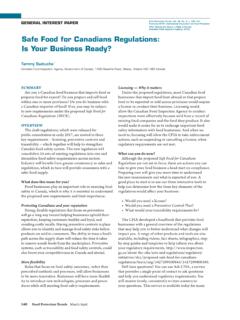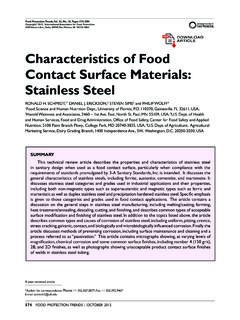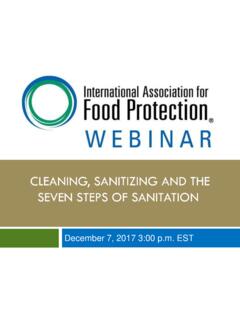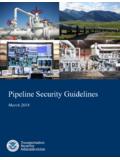Transcription of Food Transportation Safety: Characterizing Risks and ...
1 ARTICLES. food Protection Trends, Vol. 30, No. 4, Pages 212 222. Copyright 2010, International Association for food Protection 6200 Aurora Ave., Suite 200W, Des Moines, IA 50322-2864. food Transportation safety : Characterizing Risks and Controls by Use of Expert Opinion Nyssa Ackerley,1* Aylin Sertkaya1 and Rachel Lange2. 1. Eastern Research Group, Inc., 110 Hartwell Ave., Lexington, MA 02421, USA; 2 food and Drug Administration, Center for food safety and Applied Nutrition, 5100 Paint Branch Parkway, College Park, MD 20740, USA. INTRODUCTION. ABSTRACT Each year, 200 billion metric tons Federal regulations stipulate that food products be protected of food are transported globally 35. against physical, chemical and microbial contamination during percent by land, 60 percent by sea, and 5. percent by air (3). The sheer quantity and Transportation and holding. An expert opinion elicitation variety of foods transported, along with was conducted to assess food safety hazards and preventive the multitude of container, temperature, controls associated with the Transportation and holding of and handling requirements for each food food commodities.
2 Frequency and severity risk rankings product, emphasizes the vulnerability of suggest five food safety hazards of greatest concern across all the food industry to possible contamina- modes of transport: (1) lack of security; (2) improper holding tion during transport and storage (8). practices for food products awaiting shipment or inspection; Risk factors for contamination include (3) improper temperature control; (4) cross-contamination; and improper production practices, tempera- ture abuse, unsanitary cargo areas, im- (5) improper loading practices, conditions, or equipment. Factor proper loading or unloading procedures, analysis suggests that in-transit and organizational risk factors damaged packaging, shipping containers might explain the relationships among the various food safety in ill repair, bad employee habits, and hazards. Raw seafood, raw meat and poultry, and refrigerated raw road conditions. There is, however, cur- and ready-to-eat foods have the highest overall risk (in descend- rently very little information on the state ing order) across all modes of transit.
3 Our analysis also identified of food Transportation and holding prac- a range of preventive controls that may help eliminate/mitigate tices in the United States. the Risks to food during transport and storage, including: employee Current federal regulations stipu- late that food products be protected awareness and training, management review of records, and good against physical, chemical and micro- communication between shipper, transporter and receiver. bial contamination during transporta- tion and holding (21 CFR ). (19). The Sanitary food Transportation Act of 2005 (Pub. L. 109-59, 119 Stat. 1144) reallocated responsibilities for A peer-reviewed article food Transportation safety among the *. Author for correspondence: ; Fax: US Department of Health and Human E-mail: 212 food PROTECTION TRENDS | APRIL 2010. Services (DHHS), the US Department savings and the trucking industry's cur- percent of respondents of Transportation (DOT), and the US rent challenges with fuel surcharges, engage in backhauling (trans- Department of Agriculture (USDA) and driver shortages, and Hours of Service porting a different load in the requires the Secretary of DHHS to issue (HOS) regulations for commercial mo- empty truck on a return trip), rules setting up sanitary food transport tor vehicle drivers (16).
4 Current law reg- although only percent in- practices (13). It also amends section 402 ulates the number of consecutive hours dicate achieving 81 to 100 per- of the Federal food , Drug, and Cosmetic that commercial motor vehicle drivers cent of their backhauls. Act (21 USC 342(i)) so as to render may be on-duty (49 CFR 395) (18), percent of respondents unsanitary transport adulteration (1). thereby increasing the number of driv- outsource some or all of their Supply chains are quite similar ers required by the industry. Intermodal Transportation ( percent across most products, food and non- food . freight Transportation involves the use of outsource 75 to 100 percent of A tier of suppliers serves manufacturing/ multiple modes of Transportation (truck, their Transportation budget). rail and ship) for the same shipment production facilities. These facilities then A number of these findings may be without handling the freight between serve distribution facilities, which even- significant with regard to food transpor- modes ( , truck trailer transferred to tually serve retailer outlets, which in the tation safety .)
5 Driver shortages and capac- flatbed railcar). Some suppliers may be case of food , include restaurant retail ity problems may result in a lack of driver taking advantage of economies of scale in facilities that serve the end consumer. education in and adherence to proper boxcar shipping and utilizing intermodal Such supply network systems might procedures for the safe Transportation of Transportation to develop more regional- be quite complex as there can be addi- ized trucking routes in response to driver food . Backhauling increases the risk for tional first tier and second tier suppliers. preferences for short-haul rather than cross-contamination if potentially haz- Although many companies organize the long-haul trucking (16). ardous foods or other items are carried in transport of their goods internally, some In the complex food Transportation succession without proper sanitation be- food manufacturers use third-party lo- system, the earlier an undetected problem tween loads.
6 Finally, manufacturers who gistics providers (3 PLs) to outsource is introduced into the system, the higher outsource their Transportation needs Transportation procurement. A 3PL is a the risk (as measured by exposure like- relinquish control of the safety of their firm that provides outsourced, or third lihood and impact); that is, a problem product as it moves from the processing party, logistics services to companies that is introduced at an earlier stage in facility to the retailer. Good commu- for part or sometimes all of their supply the supply chain can spread out to many nication and management systems are chain management function. Third-par- distributors, retailers and then to con- required to maintain product integrity ty logistics providers typically specialize sumers just because of the structure of throughout the distribution chain. in integrated warehousing and trans- the system. For example, [in 1994], an Sources indicate that the greatest portation services that can be scaled and estimated quarter of a million Americans got gastroenteritis after eating Schwan's concerns for food safety during transpor- customized to customers' needs based on tation are tampering and sabotage, tem- ice cream the largest outbreak of market conditions and on the demands perature abuse, and cross-contamination Salmonella poisoning in the United and delivery service requirements for (8, 15).
7 While there is limited data on States ever traced to a single source. their products and materials. Environmental health specialists event- food safety failures that are directly at- Although certain food supply chain ually tracked down the cause. Liquid tributable to Transportation and storage systems require bulk transport, such as eggs laced with the Salmonella bacteria practices, some industry experience sug- rail, barge or inland water, truck trans- were transported to a factory in tanker gests that such incidents may be widely portation dominates most food supply trailers. These same trucks later hauled underreported (8). An expert opinion chain systems, especially toward the con- pasteurized ice cream base to another elicitation study was conducted to char- sumer end of the chains (6). Truck trans- plant, and the bacteria came too (7). acterize baseline practices in the sectors porters are typically involved in moving Saddle Creek Corporation, a third- involved in food Transportation (local goods among manufacturers and dis- party logistics provider (3PL), conducted and long distance general freight truck- tributors, distributors and retailers, and a survey of food and beverage warehous- ing, rail and deep sea freight transporta- even further up the chain between sup- ing and Transportation management tion, refrigerated warehousing and stor- pliers and production points.)
8 Particularly executives (12). The majority of respon- age, etc.) and identify areas where food for perishable foods, trucking remains dents were grocery companies, food and beverage processors or other third-party is at risk for adulteration. the cheapest and most flexible mode of food transport (4). In the United States, logistics providers. The survey, intended The objectives of this study were about 80 percent of all food shipments to identify common practices, challeng- twofold: (1) To identify the main prob- (12) and 91 percent of all temperature- es, and emerging trends, found that: lems that pose microbiological, chemical, controlled freight shipments, including Capacity problems, driver and/or physical safety hazards to food about million tons of refrigerated shortages, and customer de- during Transportation and storage, and fruit and vegetables (17), are transported mands are the food transporta- (2) to determine the preventive controls by truck (9).
9 Tion industry's top challenges. that could address the problems identi- Railroad and intermodal transpor- food safety is the 6th highest fied. The study enables the identification tation have received increased attention logistics challenge (indicated by of those food product types and modes recently because of their potential cost percent of respondents). of Transportation where the hazards are APRIL 2010 | food PROTECTION TRENDS 213. Table 1. Expert participants and affiliations Expert Affiliation Jim Balestra Safefreight Technology; Latium Fleet Management Betsy Blair AIB International, Inc. Craig Cahill Allen Lund Company, Perishable Logistics Division Clifford M. Coles Consulting Microbiology of California, Inc. John Conley National Tank Truck Carriers, Inc. Roy Costa Environ Health Associates Patrick Floyd Nordic Cold Storage Peter Friedmann Agriculture Transportation Coalition Fletcher Hall Hall & Associates, LLC. Dan Jenkins Grapple Hook Marketing Chris Kozak Willis Shaw Express Russell Laird Agriculture and food Transporters Conference (AFTC).
10 Peg Sarinyamas Feeding America Gary Sherlaw food safety Consulting International (FSCI). Richard F. Stier Consulting food Scientists Gerald Wojtala Association of food and Drug Officials; Michigan Department of Agriculture of high importance for public health. perts through a moderator (5, 10, 11). panel included participants from trade Further, information on preventive con- Although variations of the method associations, logistic research institutes, trols may help identify the most effective exist, in a typical Delphi study, experts academia, third-party logistics firms, food Transportation and storage practices. make individual judgments. Next, these companies that provide logistics sup- judgments are shared anonymously port, and independent consultants with with the whole group. After viewing experience in consulting to food com- MATERIALS AND METHODS other experts' judgments, each expert panies of varying sizes on logistics and is then given the opportunity to revise Transportation safety issues (Table 1).








